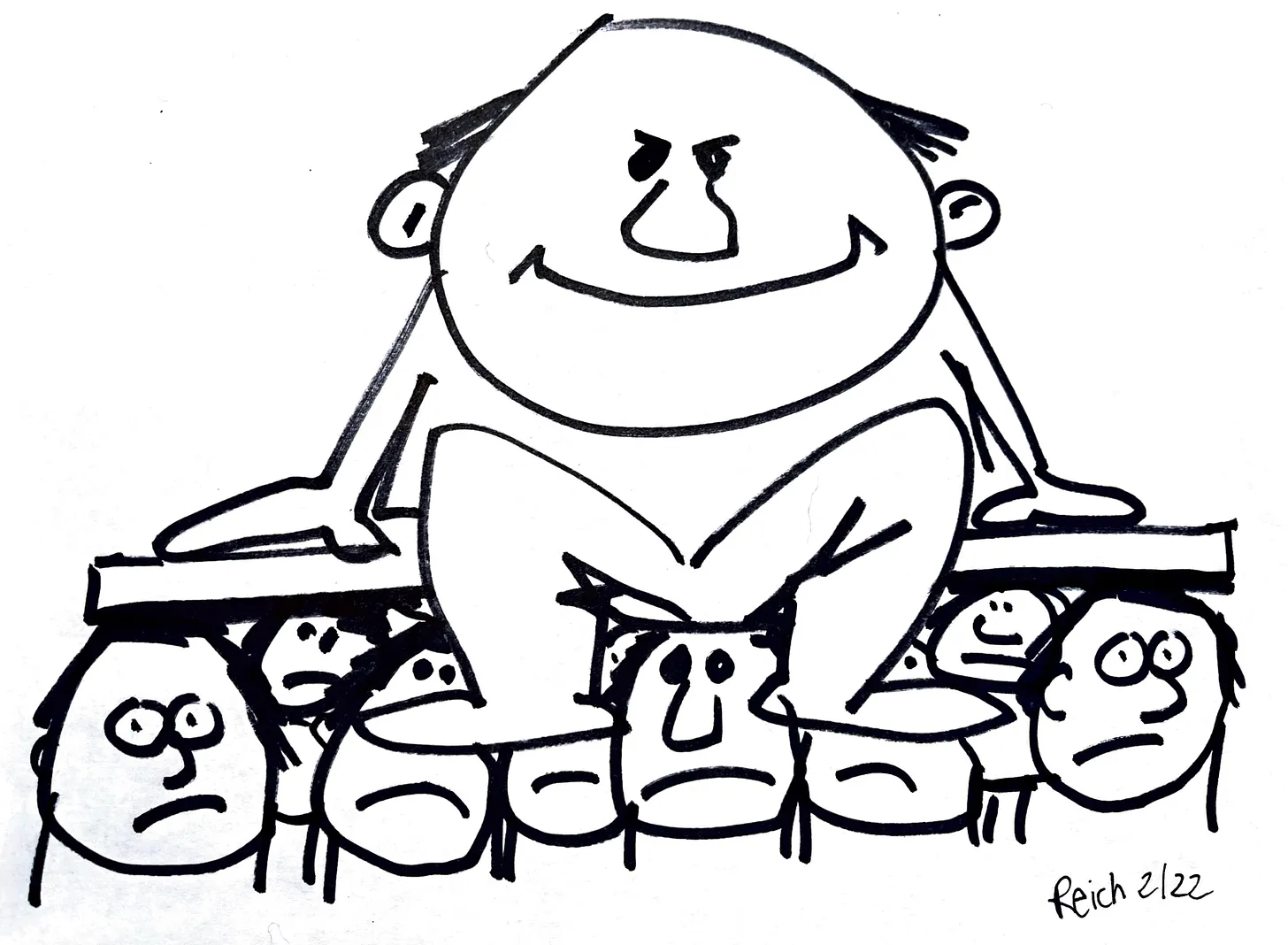Today’s evidence.
- How MAGA is a gang mentality for white men who feel powerless;
- Adam Gopnik considers the difference between a mob and a righteous protest;
- (And I wonder about the American revolutionaries);
- Short items about Robert Reich and overereaching billionaires; a reason to avoid public schools in Texas; and phony MAGA masculinity.
Beginning with gang mentality.

Salon, Chauncey DeVega, 18 Nov 2024: Why MAGA won: Anger, resentment and “a sense of betrayal”, subtitled “Understanding the deep, visceral appeal of MAGA: It’s a ‘gang mentality’ for white men who feel powerless”
and
Washington Post, Isaac Stanley-Becker and Ellen Nakashima, 14 Nov 2024: Go bags, passports, foreign assets: Preparing to be a target of Trump’s revenge, subtitled “Some prominent critics of Donald Trump, and those he has vilified as ‘deep state’ saboteurs, are taking seriously his vow of retribution.”
The Salon piece includes several interviews, including one from Randolph Hohle, a professor at SUNY Fredonia:
America’s mainstream news media and pundits got this so wrong because they don’t see that MAGA appeals to poor white men, uneducated white men and working-class white men because they don’t have anywhere else to go. It’s not about power or domination because they don’t have any power. It’s about them trying to find a place where they belong. They are socially isolated from mainstream institutions and MAGA gives them a purpose –- although I’m not sure what that purpose is. In the 1980s and 1990s, we talked about the need to create institutions to keep kids off the streets and out of gangs. MAGA is the streets for marginalized white men. “Owning the libs” is just a middle finger back to mainstream society. There is no ideology. Just a gang mentality.
As always, this may be part of the big picture, but only a part. There is no one reason for anything.
\\\
Mob mentality.

The New Yorker, Adam Gopnik, 18 Nov 2024: What’s the Difference Between a Rampaging Mob and a Righteous Protest?, subtitled “From the French Revolution to January 6th, crowds have been heroized and vilified. Now they’re a field of study.”
A long piece which I can’t begin to summarize, but here’s a paragraph in which Gopnik describes some of the issues involved.
Have crowds actually changed, or is it simply that the words we use to describe them have altered over time? Are crowds, in reality, only ever-shifting gatherings of rational individuals? Or do people, assembled together into a seething group, become, as the Bulgarian British writer Elias Canetti believed, a thing unto itself, acting in ways that none of the individuals in the group would have undertaken alone? The January 6th crowd was clearly composed of some who wanted to act and many who merely went along. Canetti distinguished between “closed” and “open” crowds: the open crowd, like the one that stormed the Bastille, is the kind in which many people of different allegiances come together for a common, if often ill-defined, cause; the closed crowd is an organized gathering for a predefined purpose. Whether you think the Trumpite mob was a closed crowd (an assembly of paramilitaries with a clear goal of creating enough chaos to end the electoral count) or an open one (a confused agglomeration that scarcely knew where it was going or what it would do until it got there) probably affects your degree of panic or fear about what another Trumpite mob might do.
My oft-mentioned observation/recommendation is to avoid crowded events, because you cannot think for yourself there; your own sense of reason is overwhelmed by the crowd in the sports stadium, the concert venue, the religious congregation. Think for yourself; read books, by yourself. Otherwise you’ll just be another member of the herd.
Anyway, this piece is in part a review of a book.
Closed or open, crowds persist as historical agents, and have become a field of study all their own. In his new book, “The Crowd in the Early Middle Ages” (Princeton), Shane Bobrycki, a medieval historian at the University of Iowa, describes a hinge moment in the way people have thought about crowds. It was a period when the rapid de-urbanization of society had reduced or eliminated the Roman vulgus, or mob, but when memories of Roman order and disorder lingered. Bobrycki has devoted himself to a blessedly old-fashioned kind of scholarship, digging through ever-finer shades of meaning, sifting through all the Latin terms that refer to crowds and mobs and gatherings. If you have long wanted to discern the subtle differences in medieval Europe between vulgus, plebs, turba, populus, and rustici, here at last is the book to assist you.
I’ll jump to the end, since there Gopnik mentions a supposedly beneficial effect (the wisdom of the crowd):
Can we speak of the wisdom of crowds? Sometimes. The madness of mobs? Sometimes, too. Perhaps, within the winningly minute range of terms that Bobrycki captures, vulgus and populus and the rest, lies a truth that resonates through centuries, even millennia. We see the shifting varieties of human assembly and search to give them meaning, when the meaning lies exactly in the mutability. To turn a crowd into a mob is always easy; nor should we be surprised when four days later, or four years later, the anarchic mob resisting power becomes the power to be resisted. A crowd can become a mob; a crowd can even become an army. To turn a crowd into a community? Ah, that’s the hard work.
Another personal comment. How do we tell the difference between the Trump mobs who stormed the Capitol on January 6th, and, say, the American revolutionaries who protested against the British back in 1776 or so? It’s hard not to wonder whether revolutionaries of any era aren’t simply violent mobs. We venerate them because they won. Answer: I don’t know. But I do observe that the American revolutionaries wrote passionate claims for their freedom, at a complete opposite end of the literacy spectrum from Trump’s mobs, who famously can’t write protest posters without misspelled words.
\\\
Shorter items today.

- Robert Reich: The wrecking-ball crew and the looting of America, subtitled “History guarantees that Trump’s billionaires will overreach”
- NY Times, 18 Nov 2024: Texas Education Board to Vote on Bible-Infused Lessons in Public Schools, subtitled “A new curriculum would focus on Christianity more than other religions. A kindergarten lesson on the Golden Rule, for example, would teach about Jesus and his Sermon on the Mount.” Comment: *This* would be a reason to avoid public schools, in Texas. Do these people not understand the purpose for the separation of church and state? The purpose was exactly about people like these.
- Salon, Amanda Marcotte, 14 Nov 2024: Fox News host Pete Hegseth as defense secretary: Perfect symbol of phony MAGA masculinity, subtitled “Donald Trump pretends to love toughness, but the MAGA model of masculinity is snowflakes like this guy”





